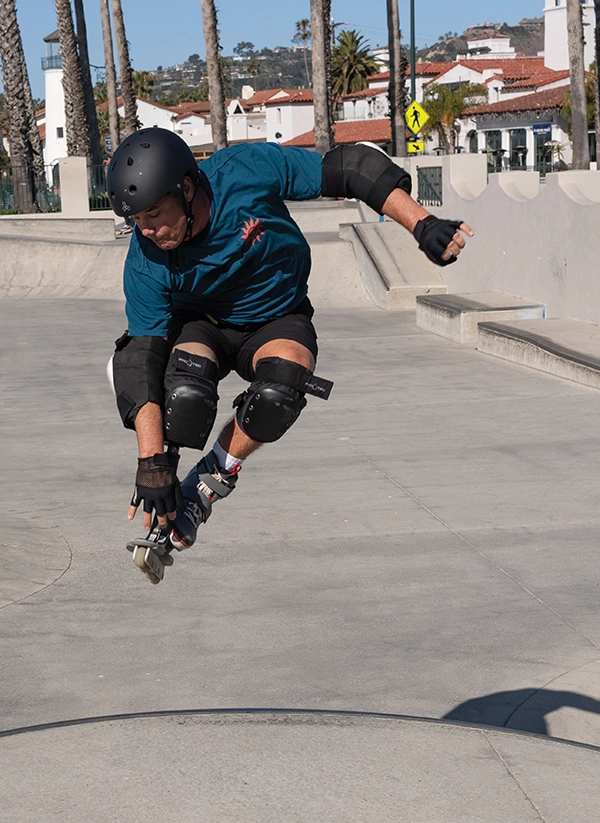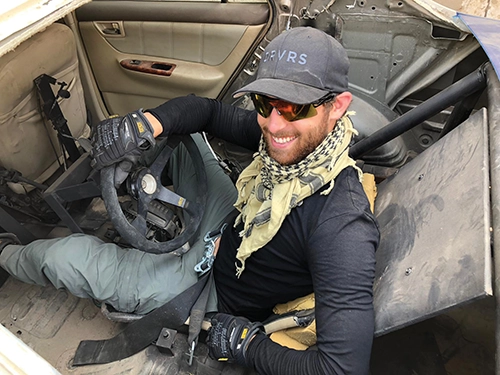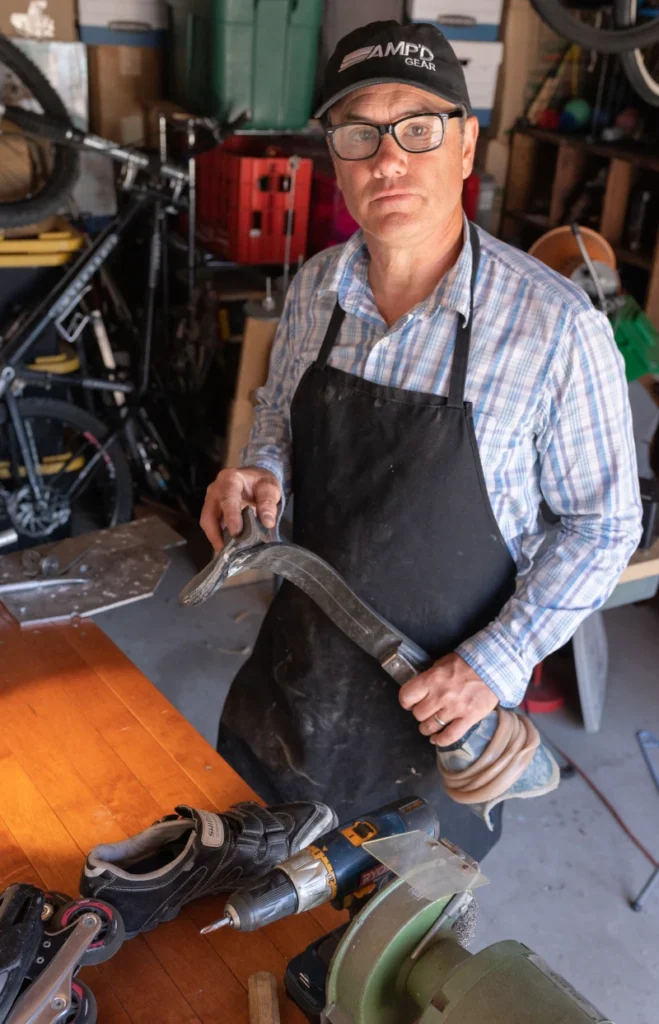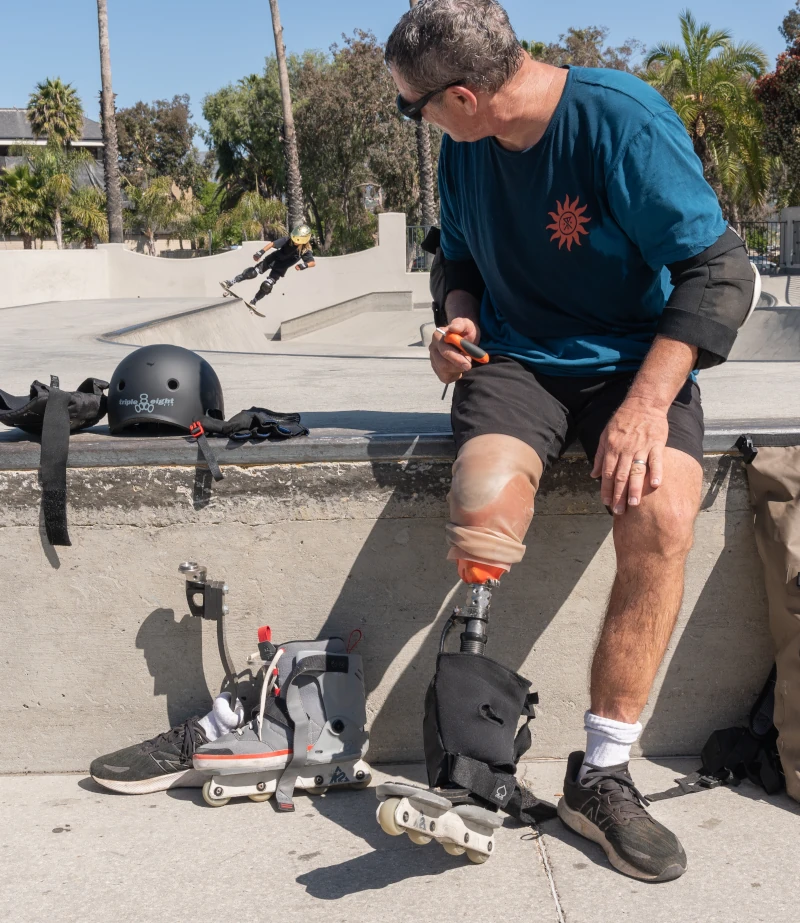It took years for amputee stunt performers to get a fair shake in the industry. Now the opportunities are coming fast and furious.
By Dailyn Matthews
EXT. SAIPAN, JAPAN – DAY
Smoke billows through palm trees on the tropical island of Saipan, its serene mountains of green juxtaposed against the violence unfolding. Planes drop bombs overhead, as soldiers battle to stay alive. Explosions light up the sky while tanks rumble alongside men as they charge through a field under heavy gunfire. A mortar sends a soldier flying through an eruption of flames and debris. A fellow Marine rushes over to render aid; his comrade’s leg is gone. He hoists the wounded man onto his back and starts to run, as both soldiers are consumed by another fireball.

Cut! A crew member screams, thinking a horrible accident has caused a traumatic amputation right there on set. But the “injured” actor, a stunt performer named Casey Pieretti, is completely unhurt. The scene went exactly as the team had planned it. Pieretti, a real-life amputee since his late teens, helped design the “gag” that would blow his prosthetic leg off in a safe, calculated manner, while making audiences (and even some of the production crew) believe he’d suffered a terrible combat wound.
That film, a 2002 World War II drama called Windtalkers, earned three World Stunt Award nominations and solidified Pieretti’s reputation as one of the industry’s most unique talents. In the years since, he’s worked on Marvel blockbusters, Spielberg productions, and major TV shows such as Breaking Bad, NCIS, and Yellowstone. He’s appeared in projects starring Tom Cruise, Kevin Costner, Charlize Theron, and other A-listers.
But Pieretti’s biggest career achievement has been to blaze the trail for other stunt performers with limb difference. One of those protégés, Brett Smrz, met Pieretti on the set of Windtalkers as an able-bodied 11-year-old. Five years later, when Smrz lost his leg in an accident, he knew he could still pursue his ambitions and achieve excellence in any profession, no matter how competitive.
Because he’d already seen Pieretti do it.

Casey Pieretti. Photo by Dailyn Matthews.
PIERETTI WAS ON A college basketball scholarship when he lost his right leg in 1985 after being hit by a drunk driver. His father and brother had both been killed by drunk drivers earlier that year, making the trauma all the more devastating. Such suffering would have extinguished the light in many people, but Pieretti was an athlete, and athletes thrive on competition. The life he had known was gone. The accident forced him to look for new challenges.
Pieretti gravitated toward inline skating, splitting a pair of skates with a left leg amputee. He propelled himself on one leg, without a prosthesis, and used arm crutches for balance and speed. He struggled at first, but the skating community embraced him with open arms, displaying an inclusive spirit that was well ahead of its time. He began performing at live events and made national news in 1993 by skating all the way across the continent to raise money for a prosthetic limb bank serving amputee kids.
After the Blade Across America tour, Pieretti sought to carve out a career in the Hollywood stunt industry. But the filmmaking business wasn’t nearly as open-minded as the skate community. Pieretti faced enormous prejudice, being told by numerous stunt coordinators that an amputee would never get hired. He finally got a break in 1997, when the stunt coordinator of the sci-fi flick Starship Troopers needed a performer for a limb-loss scene. That was followed by appearances in big-budget films like Get Carter (with Sylvester Stallone), We Were Soldiers Once (Mel Gibson), and Windtalkers (Nicolas Cage).
As he gained experience, Pieretti began designing and fabricating his own legs for specific movie-stunt purposes, including devices that could be blown off in explosions or broken in fights. Prosthetic manufacturers began turning to Pieretti for input on their products, knowing he would test them to their limits and give useful insight about what felt comfortable, where the failure points were, and just how much high impact a device could withstand.
Pieretti understands that every amputee is unique, and one-size-fits-all solutions rarely work. Finding the perfect fit can take arduous effort. The same principles apply to stunt performers. By presenting his limb difference as a distinctive benefit, rather than an obstacle, Pieretti has carved out a niche for himself and opened the door for future amputee performers. Over the years, he has helped many young amputees navigate the industry, providing them with training and helping them build stunt arms and legs to enhance their abilities. “Whenever possible, create and share opportunity,” he says.
Despite occasional accusations that he has exploited his limb difference to gain an advantage, Pieretti is proud of his career. Above all, he’s proud of standing up for himself and refusing to accept the limitations that other people tried to place on him.
“If you can be under that kind of pressure and keep it together,” Pieretti says, “that is what it is like to be a stuntman.”
EXT. FLORENCE, ITALY – DAY
A neon green Alfa Romeo screams through the historic streets of the famous city, dodging oncoming cars, nuns on bicycles, and gunfire coming from a fleet of pursuing vehicles. The Alfa roars down alleys barely wide enough for a car, blasts through cafe tables, and sends pedestrians diving for cover and motorcyclists flying through the air. It slides through the corners with smoke billowing off the back tires. After more than five minutes of death-defying action, the stealth machine escapes, leaving a city’s worth of wreckage in its wake.
That scene, from the 2019 Netflix action film 6 Underground, has been described as “the craziest car chase that has ever been committed to film.” And there was one driver the producers trusted to hit every mark and execute every turn without scuffing a single brick on any of the city’s irreplaceable landmarks.
Brett Smrz. Who happens to be an amputee.

Brett Smrz, stunt driver extraordinaire.
He’d never met anyone with a prosthetic leg until he saw Pieretti performing on the set of Windtalkers. Smrz and his dad, Gregg (the film’s stunt coordinator), watched in amazement as Pieretti took off running in full military gear, moving as fast as the able-bodied stuntmen around him.
“Ever since that day, I have always thought differently of amputees,” Smrz says. “When I was presented with losing my leg, my initial thought was of Casey sprinting across a field.”
The threat of limb loss occurred in 2007, after the 16-year-old Smrz attempted a barani (twisting flip) onto a trampoline with some friends. The thrill-seeking teen, who hails from a family of stunt coordinators, was already a national champion on the go-kart circuit by then, and he seemed headed toward a lucrative career as a professional race car driver. Just for fun, he launched the barani stunt from the second story to make it more spectacular.
What was spectacular was the injury he sustained after overrotating during the trick: a spiral plateau fracture of the left tibia. In the ambulance on the way to the hospital, Smrz didn’t feel pain and even wondered, “Are they going to have to amputate my leg?” He sustained excessive damage to nerves, and the leg swelled so badly that doctors spent three days trying to close the wound. On the third day, the tissue had decayed to the point of no return, and Smrz’s leg was amputated mid-calf.
Smrz’s mother wept uncontrollably when the doctor explained that amputation was unavoidable, but her son assured her he would be fine. His thoughts had already turned to images of Pieretti and Italian race car driver Alex Zanardi, who returned to the auto-sports circuit after losing both legs in a crash.
“People can make a huge mental impact on you when you are presented with a life-altering situation,” Smrz says. “Casey did that for me. Hopefully my message will do the same for someone else.”

Brett Smrz is one of Hollywood’s most popular stuntmen.
Photo by Dailyn Matthews.
Three months after his amputation, he was back behind the wheel at Laguna Seca Raceway, operating the clutch on his go-kart via a special bracket that kept his prosthetic foot on the pedal. He recorded his fastest race to date that day, while learning to adapt to the changed shape of his foot and the inability to bend his prosthetic ankle. His natural abilities more than made up for those limitations.
Despite his family connections, Smrz didn’t have much desire to work as a stuntman. But when he got the opportunity to try stunt driving, he jumped at it. On his first day on set for the 2009 film Surrogates, he had the amazing good fortune of getting assigned to do a T-bone at 45 mph. Most stunt drivers relish the chance to do something sensational, and T-bones usually produce spectacular results. Three takes and Smrz was hooked.
He had thought of himself as an excellent driver because of his racing experience. But stunt driving required a whole other layer of excellence, one that favored precision over speed. Being mentored by some of the best in the business, Smrz learned to skid right up to the edge of a canyon, mimicking a stop inches from a camera crew. Drivers Inc., a world-class team of stunt professionals, brought him on board and helped him advance to prestigious car commercials, TV shows, and feature films.
Early in his career, Smrz worked on Jack Reacher and two Mission: Impossible films. All three starred Tom Cruise, whose scripts routinely include ambitious stunt work. In 2018, Smrz got a fantastic opportunity to showcase his skills: a rollover off a pipe ramp for an episode of Fear the Walking Dead. This stunt involved driving up a metal ramp, which launched the vehicle into a corkscrewing flip. (These gems don’t come along that often. I’ve been begging to do this stunt my whole career.) Smrz delivered on the difficult stunt, helping to build his reputation as the guy to hire.
The next year he was entrusted with the insanely difficult chase scene in 6 Underground. Smrz also enjoyed a brief burst of internet fame when a fan posted a photo of him in costume as Ant-Man, while serving as Paul Rudd’s stunt driver. He has worked almost nonstop ever since, flying to sets all over the globe. Within the next year or two, you’ll see Smrz driving Mirage, the silver Porsche 911, in Transformers: Rise of the Beast; doing stunts to kick off the new John Wick mini-series The Continental; taking his first acting cameo in Ferrari; and completing his first stunt cocoordinator gig on a John Woo film called The Killer.
Smrz’s advice for anyone facing limb loss or another disability is simple. “If you have something that completely alters your path, just know there’s always a way to make it work,” he says. “Don’t give up on your dreams.”
EXT. RURAL TEXAS DIRT ROAD – DAY
A rusty, battle-worn Freightliner truck, looking like something out of Mad Max, barrels down the road with a weathered woman behind the wheel. The front of the truck has a makeshift cowcatcher welded to its bumper, and as the camera zooms out from the windshield, we see a snarling walker harpooned by the rig, lower body ripped off, blood and guts everywhere. The truck stops, and the driver gets out, walks around to the front of the vehicle, and says: “Well, shit.” She takes a crowbar to the walker’s head and rips her off the grill, tossing her on the ground.

The stunt performer underneath all that phenomenal zombie makeup, Kanya Sesser, had Pieretti (who else?) to thank for the opportunity. A relative newcomer to the stunt industry, she first appeared on screen in a 2015 episode of Code Black, playing an all-too-familiar role for amputee actors: accident victim. A few other small jobs followed. Then Pieretti gave Sesser’s name to the stunt coordinator of Fear the Walking Dead, who needed a candidate for the gag involving the Freightliner and the impaled walker. It was a specialty stunt that only an amputee could perform, and there are very few female amputees in the stunt community. The coordinator hired the relatively inexperienced Sesser based on Pieretti’s recommendation.
As a skilled athlete, Sesser was well prepared for the rigors of stunt work. And she possessed more than the necessary amount of toughness and grit. She was abandoned as an infant in her native Thailand. Somebody found her in the bushes on the side of a road near Pak Chong, wrapped in a pink blanket and covered in bug bites and dirt. The baby was taken to the nearest hospital, where nurses discovered that she had no legs. Finding no evidence of injury or foul play, they determined the limb difference was congenital.
The child lived at the hospital for the next five and a half years. She was mainly raised by a compassionate nurse named Mae Chong, who feared the young girl would be abused because of her disability if she were adopted into a Thai home. Mae taught her how to take care of herself and warned the youngster not to depend on others for support. The girl was fiercely independent by nature, becoming frustrated when anyone tried to help her accomplish a task. Surrounded by a village of caregivers, she became the darling of the hospital.
In 1998, she was adopted by Jane and Dave Sesser of Portland, Oregon. Transitioning to a new home, family, country, and language would be challenging for any child. Doing it as a bilateral amputee required extra toughness. But, thanks to the independent spirit the Thai nurses had instilled in her, Sesser held her own in the United States. By age nine she had learned how to skateboard; by 16 she was competing in the ESPN X-Games and winning second place in Women’s Street Adaptive on the Dew Tour. She now has taken up monoskiing, with the hope of eventually competing in the Paralympics.
Sesser doesn’t like the term “limb difference” and doesn’t think of herself as disabled. “What is normal?” she asks. “I’m not normal. No one’s normal. We’re all unique, and at the end of the day we’re all one people. And it’s so beautiful.”

Although her athleticism and discipline make her a natural for stunt work, Sesser’s real love is acting. This summer she began work on an independent production called The Keeper, playing the lead role of Ruby. That’s a rare opportunity, according to Nicole Cyrille, who chairs the SAG-AFTRA Performers With Disabilities Committee. It’s estimated that only 3 percent of scripted characters are people with disabilities, and only 1 percent are played by actors with disabilities.
Although progress seems to be occurring, it’s impossible to know because production companies don’t officially track the employment of performers with disabilities. The industry’s formal Casting Data Reports include checkboxes for race, gender, and age, but there’s no box for disability—despite years of promises to include one.
Despite the absence of reliable statistics, Cyrille is encouraged that performers such as Pieretti, Smrz, and Sesser have a shot at making a living. She urges audiences to make noise, demand more inclusive content, and support films that represent disability authentically—with authentically cast actors.
“It will be a more beautiful world when we see each other for our hearts,” she says, “and not be judged by our differences or disabilities.”
Dailyn Matthews is a stuntwoman, writer, & adventure photographer. Her film and TV credits include Ford v. Ferrari, The Walking Dead, Mad Men, and Spiderman 2.




